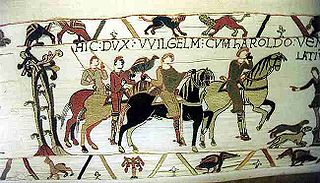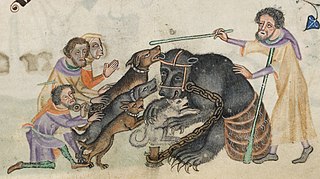
The coyote is a species of canine native to North America. It is smaller than its close relative, the wolf, and slightly smaller than the closely related eastern wolf and red wolf. It fills much of the same ecological niche as the golden jackal does in Eurasia. The coyote is larger and more predatory and was once referred to as the American jackal by a behavioral ecologist. Other historical names for the species include the prairie wolf and the brush wolf.

The wolf, also known as the gray wolf or grey wolf, is a large canine native to Eurasia and North America. More than thirty subspecies of Canis lupus have been recognized, including the dog and dingo, though gray wolves, as popularly understood, only comprise naturally-occurring wild subspecies. The wolf is the largest extant member of the family Canidae, and is further distinguished from other Canis species by its less pointed ears and muzzle, as well as a shorter torso and a longer tail. The wolf is nonetheless related closely enough to smaller Canis species, such as the coyote and the golden jackal, to produce fertile hybrids with them. The wolf's fur is usually mottled white, brown, gray, and black, although subspecies in the arctic region may be nearly all white.

White Fang is a novel by American author Jack London (1876–1916) — and the name of the book's eponymous character, a wild wolfdog. First serialized in Outing magazine between May and October 1906, it was published in book form in October 1906. The story details White Fang's journey to domestication in Yukon Territory and the Northwest Territories during the 1890s Klondike Gold Rush. It is a companion novel to London's best-known work, The Call of the Wild (1903), which is about a kidnapped, domesticated dog embracing his wild ancestry to survive and thrive in the wild.

A bark is a sound most often produced by dogs. Other animals that make this noise include, but are not limited to, wolves, coyotes, foxes, seals, and barking owls. "Bark" is also a verb that describes the sound of many canids.

Royal hunting, also royal art of hunting, was a hunting practice of the aristocracy throughout the known world in the Middle Ages, from Europe to Far East. While humans hunted wild animals since time immemorial, and all classes engaged in hunting as an important source of food and at times the principal source of nutrition. The necessity of hunting was transformed into a stylized pastime of the aristocracy. More than a pastime, it was an important arena for social interaction, essential training for war, and a privilege and measurement of nobility. In Europe in the High Middle Ages the practice was widespread.

Wolf hunting is the practice of hunting wolves. Wolves are mainly hunted for sport, for their skins, to protect livestock and, in some rare cases, to protect humans. Wolves have been actively hunted since 8,000 to 10,000 years ago, when they first began to pose a threat to livestock of Neolithic human communities. Historically, the hunting of wolves was a huge capital- and manpower-intensive operation. The threat wolves posed to both livestock and people was considered significant enough to warrant the conscription of whole villages under threat of punishment, despite the disruption of economic activities and reduced taxes. The hunting of gray wolves, while originally actively endorsed in many countries, has become a controversial issue across the globe. Most people see it as cruel, unnecessary and based on misconceptions, while proponents argue that it is vital for the conservation of game herds and as pest control.

A pack is a social group of conspecific canines. The number of members in a pack and their social behavior varies from species to species. Social structure is very important in a pack. Canine packs are led by a breeding pair, consisting of the alpha male and alpha female.

The Eurasian wolf, also known as the common wolf, is a subspecies of grey wolf native to Europe and Asia. It was once widespread throughout Eurasia prior to the Middle Ages. Aside from an extensive paleontological record, Indo-European languages typically have several words for "wolf", thus attesting to the animal's abundance and cultural significance. It was held in high regard in Baltic, Celtic, Slavic, Turkic, ancient Greek, Roman, Dacian, and Thracian cultures, whilst having an ambivalent reputation in early Germanic cultures.

Rat-baiting is a blood sport that involves releasing captured rats in an enclosed space with spectators betting on how long a dog, usually a terrier, takes to kill the rats. Often, two dogs competed, with the winner receiving a cash prize. It is now illegal in most countries.
Human-baiting is a blood sport involving the baiting of humans against dogs. There are at least three known documented cases of human-baiting, all of which occurred in England in the 19th century.

Monkey-baiting is a blood sport involving the baiting of monkeys against dogs.

The domestication of the dog was the process which led to the domestic dog. This included the dog's genetic divergence from the wolf, its domestication, and the emergence of the first dogs. Genetic studies suggest that all ancient and modern dogs share a common ancestry and descended from an ancient, now-extinct wolf population – or closely related wolf populations – which was distinct from the modern wolf lineage. The dog's similarity to the grey wolf is the result of substantial dog-into-wolf gene flow, with the modern grey wolf being the dog's nearest living relative. An extinct Late Pleistocene wolf may have been the ancestor of the dog.

Animals in sport are a specific form of working animals. Many animals, at least in more commercial sports, are highly trained. Two of the most common animals in sport are horses and dogs.

Dog behavior is the internally coordinated responses of individuals or groups of domestic dogs to internal and external stimuli. It has been shaped by millennia of contact with humans and their lifestyles. As a result of this physical and social evolution, dogs have acquired the ability to understand and communicate with humans. Behavioral scientists have uncovered a wide range of social-cognitive abilities in domestic dogs.

Bear hunting is the act of hunting bears. Bear have been hunted since prehistoric times for their meat and fur. In addition to being a source of food, in modern times they have been favored by big game hunters due to their size and ferocity. Bear hunting has a vast history throughout Europe and North America, and hunting practices have varied based on location and type of bear.

Bear-baiting is a blood sport in which a chained bear and one or more dogs are forced to fight one another. It may also involve pitting a bear against another animal. Until the 19th century, it was commonly performed in Great Britain, Sweden, India, Pakistan, and Mexico among others.

Wolves are sometimes kept as exotic pets, and in some rarer occasions, as working animals. Although closely related to domesticated dogs, wolves do not show the same tractability as dogs in living alongside humans, and generally, a greater amount of effort is required in order to obtain the same amount of reliability. Wolves also need much more space than dogs, about 25 to 40 square kilometres so they can exercise.

The nature fakers controversy was an early 20th-century American literary debate highlighting the conflict between science and sentiment in popular nature writing. The debate involved important American literary, environmental and political figures. Dubbed the "War of the Naturalists" by The New York Times, it revealed seemingly irreconcilable contemporary views of the natural world: while some nature writers of the day argued as to the veracity of their examples of anthropomorphic wild animals, others questioned an animal's ability to adapt, learn, teach, and reason.

Wolf hunting with dogs is a method of wolf hunting which relies on the use of hunting dogs. While any dog, especially a hound used for hunting wolves may be loosely termed a "wolfhound", several dog breeds have been specifically bred for the purpose, some of which, such as the Irish Wolfhound, have the word in their breed name.

Bite inhibition, sometimes referred to as a soft mouth, is a behavior in carnivorans whereby the animal learns to moderate the strength of its bite. It is an important factor in the socialization of pets.




















